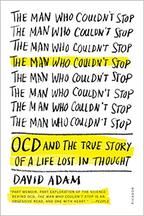Author: David Adam
ISBN-10: 1250083184
ISBN-13: 978-1250083180
APA Style Citation
Adam, D. (2016). The man who couldn't stop: OCD and the true story of a life lost in thought. New York, NY: Picador.
Buy This Book
https://www.amazon.com/Man-Who-Couldnt-Stop-Thought/dp/1250083184/ref=pd_lpo_sbs_14_img_0?_encoding=UTF8&psc=1&refRID=F7EB0H0TX69H38ZENPNE
| the_man_who_couldnt_stop_activity.pdf |
Obsessive compulsive disorder (OCD) often does not get the attention it deserves. It is the fourth most common mental disorder after the big three of depression, substance abuse, and anxiety. OCD is referred to as a “secret disease” and a “silent epidemic,” but subclincial OCD is everywhere. The stigma has lessened for some disorders, such as depression, schizophrenia, and bipolar, but there is a way to go for OCD. The book The Man Who Couldn't Stop: OCD and the True Story of a Life Lost in Thought shares the personal journey of the author, David Adam, a science writer from the United Kingdom who informs the reader of the science and history of OCD in hopes of reducing the stigma associated with the disorder.
Psychiatrists have made it clear that OCD is not an exaggerated form of everyday worries, but yet the general public often persists in thinking otherwise. A thorough explanation of the different types of symptoms is provided for the reader. Specific attention is given to intrusive thoughts. Adam goes on to explain the Pure-O form of OCD with no overt compulsions, the just-no-right experience where behaviors come first, and the high-place phenomenon where individuals commonly report wanting to jump from a window or bridge. OCD is not a problem with memory, but rather a loss of confidence that a given behavior has been successfully carried out. The author weaves his personal story with OCD that peaked in 1991 throughout the book. He would obsess about the ways he could catch AIDS. He describes how it took over his life and how he would call the National AIDS Helpline on a regular basis. Adam also provides the historical background to the diagnosis of OCD, taking it back to patient zero, Mademoiselle F, a French woman from the early 19th century. He explains models of OCD throughout the text based on the knowledge at that given time.
Over twenty separate conditions are linked to OCD, and each of these similar disorders is carefully differentiated from OCD in the book. People with phobias can avoid what causes their anxiety, but those with OCD cannot. Adam differentiates between the commonly confused OCD and OCPD. He explains hoarding and neurological disorders, such as Tourette’s syndrome and Parkinson’s disease, and their connection to OCD. In addition, he investigates connections to impulsive disorders, such as gambling, pyromania, and kleptomania. Differentiations are also provided for trichotillomania, skin-picking, body dysmorphic disorder (BDD), body integrity disorder (BII), hypochondriasis, eating disorders (anorexia or bulimia), maladaptive daydreaming, and obsessional jealousy.
Another section of the book is dedicated to the types of therapy that have historically been offered to treat OCD. He chronicles classic psychodynamic analysis, with specific attention to Freud’s contribution. Next, the behavioral approach in the 1960s and the era of aversion and thought-stopping therapy are addressed. In the 1990s the cognitive psychologists started to explore OCD and first looked at the connection to religion. While religion does not cause OCD, it provides an outlet for the symptoms. Research also focused on three dysfunctional beliefs important to OCD: Inflated sense of threat and personal responsibility, perfectionism and intolerance of responsibility, and over-importance of thought and the need to control them. These different types of dysfunctional beliefs could explain the range of symptoms.
The first modern cognitive model of OCD was based on how one reacts to thoughts. With great responsibility, comes great power. The responsibility of parenting can bring many intrusive thoughts. Adam goes on to explore postnatal OCD, which is almost unheard of in comparison to postnatal depression now recognized as a serious problem. It can take an upsetting form where mothers have powerful urges to throw their baby into a fire, cook them in a microwave, etc. It is important to note that none of this happens outside of the mother’s head, they do not act on their intrusive thoughts. The author recognizes that a substantial shift in his story happened when he found blood on his six month old’s leg. Immediately he became obsessed with the thought that he had given her AIDS. He had settled for a personal life with OCD, but never wanted to impact his family. He refused to make his daughter an accomplice and wanted his intrusive thoughts to stop with him, so he sought out therapy.
Another section focuses on animals and human patterns of behavior and ritual. Various animal examples are provided and the similarities to OCD are explored. Check out the book review Animal Madness: How Anxious Dogs, Compulsive Parrots, and Elephants in Recovery Help Us Understand Ourselves (https://booksforpsychologyclass.weebly.com/blog/category/disorderstreatment8086727c74/2). Humans like routine, whether it a sports routine, washing in the shower, or taking a path from point A to point B. The link between ritual and OCD fascinates scientists and there is a belief that ritual is useful by performing tasks with less mental effort and therefore saving energy. Other evolutionary explanations are also explained. The differences between anxiety and OCD are carefully teased apart.
The author turns back to the causes of OCD. Possible explanations are explored, including genes, early experiences and dysfunctional beliefs, inflated responsibility, parenting styles, and family accommodation of symptoms. Age ranges are provided, as well as risk factors for developing OCD. Rituals are normal for children, but some warning signs are provided. Lots of attention is devoted to the brain’s role in the development of OCD. Research involving scans are described in detail, specific brain parts and neurotransmitters are identified and explained, even the connection to Pandas- Pediatric Autoimmune Neuropsychiatric Disorders Associated with Streptococcal Infections.
Treatments are addressed once again. The variety of medications to treat OCD is explained. Before SSRIs became available in the 1980s and 1990s, patients were treated with clomipramine. The methods of cognitive behavioral therapy (CBT) are explained. Furthermore, exposure and response prevention have also been found to be successful in treating OCD. The use of systematic desensitization is explained in detail. In 2012, a comprehensive meta-analysis of CBT for OCD found more people improved with treatment, than chance alone. If you change the mind, then you can change the brain. The lobotomy is explored in detail. The author discusses the historical contributions of Phineas Gage, Egas Moniz, Walter Freeman, and James Watts. While the traditional method is no longer used, psychosurgery has provided a cautious green light to more selective stereotactic surgery, such as a cingulotomy where specific tissue is targeted and lesioned.
Politics and prejudice are also addressed. The author believes it is important to raise awareness of what OCD is and what it is not (not just about cleanliness). He explains how individuals have lost their jobs and have been separated from their families when harmless obsessions are reported. The stigma has decreased for many mental illnesses, but OCD has a long way to go. It may be due to many not viewing it as a serious disorder. Hollywood has contributed to this by treating OCD with humor and levity.
In 2013, the new Diagnostic Statistical Manual of Mental Disorders (DSM) brought attention to OCD. It was reclassified as an OCD spectrum disorder, no longer an anxiety disorder. Connections between OCD and other disorders, such as PTSD or schizophrenia are being further investigated. A short history of the DSM and Emil Kraeplin’s classification system used in Europe is explained to help the reader. Also, a critical look at the current categories approach is explored, and a dimensionality approach is offered in its replacement.
The author offers his final thoughts, looking back at his symptoms early in life. Currently, he is doing well, but he knows that he will continue to wrestle with his OCD throughout his life. He wants people to know that the bad news is that it won’t go away by itself. But the good news is that we are finding out more about how to diagnose and treat the condition. Sharing his story and many others helps us understand more about OCD.
Other Related Resources
2016 Annual OCD Conference Keynote - David Adam "The Accidental Advocate"
https://www.youtube.com/watch?v=KccklYNpTus
https://iocdf.org/blog/2016/07/07/david-adam-to-bring-humor-hope-and-books-to-this-years-ocd-conference/
The OCD Stories Podcast- Interview with David Adam
https://www.youtube.com/watch?v=WWXIq_Ir9vA
http://theocdstories.com/podcast/david-adam-the-man-who-couldnt-stop/
Understanding the OCD Brain part 1: OCD and me
https://www.youtube.com/watch?v=YpCOAqxbfpA
Addiction.com ‘The Man Who Couldn’t Stop’: A Q&A with David Adam on OCDhttps://www.addiction.com/8869/the-man-who-couldnt-stop-a-qa-with-david-adam-on-ocd/
NPR- Why OCD Is 'Miserable': A Science Reporter's Obsession With Contracting HIVhttps://www.npr.org/sections/health-shots/2015/01/12/376438311/why-ocd-is-miserable-a-science-reporters-obsession-with-contracting-hiv
New York Times Article
https://www.nytimes.com/2015/02/01/books/review/david-adams-the-man-who-couldnt-stop.html
Time Article
http://time.com/4890095/obsessive-compulsive-disorder-ocd-joke/
The Guardian Article
https://www.theguardian.com/books/2014/apr/20/the-man-who-couldnt-stop-review-david-adam-ocd-review
Psychological Figures and Concepts
Charles Darwin
Egas Moniz
Emil Kraeplin- category approach in DSM
Ivan Pavlov
James Watts
Konrad Lorenz
Mademoiselle F. (Patient zero of OCD)
Paul Broca
Phineas Gage
Rat Man- Ernst Lanzer (Freud Case Study)
Rosemary Kennedy
Sigmund Freud
Walter Freeman
Wilder Penfield
William James
Altered perception
Amphetamines
Amygdala
Anal personality
Anorexia nervosa
Anxiety hierarchy
DSM
Authoritarian
Autism
Aversion therapy
Basal ganglia
Behavioral psychologists
Bipolar
Blood-brain barrier
Body dysmorphic disorder (BDD)
Body integrity disorder
Bulimia nervosa
CAT scan
Catastrophizing
Chromosomes
Cognitive behavioral therapy (CBT)
Cognitive psychologists
Cohort studies
Co-morbidity
Compulsions
Deep brain stimulation
Depression
Dimensionality vs. category approach
Disgust
Distress scale
Dopamine
Dualism
Dysfunctional beliefs
Eating disorders
ECT
Ethics
Evolutionary psychology
Extinction
Factor analysis
Fight-or-flight response
Frontal leucotomy
Genotype maps
Glutamate
Grey vs. white matter ratio
Group therapy
Hippocampus
Hoarding
Homosexuality
Huntington’s disease
Hypochondriasis
Impulse-control disorder
Insanity
Insight
Insulin overdose
Intelligence
Kleptomania
Lesions
Lie detectors
Lithium
Lobotomy
LSD
Memory
Meta-analysis
Motor cortex
MRI
Functional MRI
Nature vs. nurture
Neurologists
Neurosis vs. psychosis
Neurotransmitters
Nucleus accumbens
Obsessions
Obsessive compulsive disorder (OCD)
Obsessive compulsive personality disorder (OCPD)
Oxytocin
Parasomnia
Parenting styles
Parkinson’s disease
Pathological gambling
PET scan
Phobias
Phrenology
Postnatal depression
Postnatal OCD
Prefrontal lobotomy
Prozac
Psychiatrists vs. psychologists
Psychoanalytic movement
Psychopath
Psychosurgery
Psychotropic medication
PTSD
Pyromania
Rational vs. irrational
Reuptake
Schizo-obsessive disorder
Schizophrenia
Self-harm
Serotonin
Skin-picking disorder
SSRIs
Stigma
Stream of consciousness
Substance abuse
Suicide
Systematic desensitization
Thalamus
Tourette’s syndrome
Trauma
Trichotillomania
Twin studies
Withdrawal symptoms
Zoloft


 RSS Feed
RSS Feed